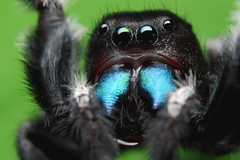 |
| Pink Bubble Tip Anemone |
Anemones use microscopic stinging cells in their tentacles called "nematocysts" in order to stun their prey, and as a defense mechanism. Once the prey is stunned, the tentacles move the now food towards the center of its disk, and into the mouth. The sting is less potent than other anemone species and under normal circumstances does not affect human tissue (Word of warning some people have reported allergies to these animals, though rare in occurrence). Under normal circumstances a single opening serves as a mouth, for both food intake and to expel waste.
These creatures are supported internally by water, which in turn houses zooxanthellae within its tentacles and body or base. The zooxanthella is what gives the anemone its color as well as a natural food source (supplemental feeding is still recommended). This is exactly why a strong light source is recommended but not necessary.These anemones have been recorded to reach sizes of up to 15 inches across at its base (not foot). Which brings us to an aquarium size of no less than 24 gallons, however several aquarists have had success with these anemones in smaller nano aquariums. This brings a whole new set of issues that will affect the health and life span of the said anemone. Some of which may include stress from cramped quarters after it outgrows its aquarium, as well as water conditions that fluctuate to often or widely. Keep in mind that in a smaller aquarium it is increasingly difficult to control the water parameters accurately, primarily due to the inpatients of the owner. Any changes to the water parameters need to be done gradually, otherwise it will be stressful for the anemone sometimes leading to death.






